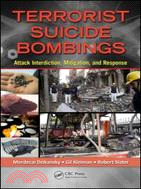Terrorist Suicide Bombings:Attack Interdiction, Mitigation, and Response
商品資訊
ISBN13:9781439871317
出版社:CRC Press UK
作者:Mordecai Dzikansky; Gil Kleiman and Robert Slater
出版日:2011/10/05
裝訂/頁數:精裝/342頁
版次:1
定價
:NT$ 8775 元優惠價
:90 折 7898 元
若需訂購本書,請電洽客服 02-25006600[分機130、131]。
商品簡介
作者簡介
目次
相關商品
商品簡介
Urban environments are prime targets for suicide bombings over the next decade. While the threat may be ever-present, measures are available that can empower law enforcement personnel to thwart attacks, or at least mitigate the effects by reducing casualties. Written by professionals with first-hand experience, Terrorist Suicide Bombings: Attack Interdiction, Mitigation, and Response helps first responders, law enforcement, and homeland security professionals grapple with this increasing threat, offering best practices in the field and lessons learned.
Advance preparation
The authors provide specific instructions on how to fortify possible suicide bombing targets, suggesting measures that—if implemented—will reduce casualties. They explain how suicide bombers operate and what weapons they are likely to employ. They also debunk common myths about suicide bombers that jeopardize successful interdiction.
Actual case studies
Including graphic photos depicting the aftermath of actual bombing scenes, the book projects the reader into the chaos of a bomb scene. Chapters describe what one encounters at a site immediately after a bombing and explain what each first responder should and should not do. Case studies throughout enhance the text, explaining why certain suicide bombings succeed while others fail.
Psychological effects
The book also explores how terrorists seek to exploit the media and describes government and media efforts to diffuse the bombers’ self-promotion. A full chapter is devoted to post-traumatic stress disorder (PTSD), a condition that commonly affects many first responders. Finally, the book closes with recommendations aimed at helping law enforcement defend against suicide bombers.
Advance preparation
The authors provide specific instructions on how to fortify possible suicide bombing targets, suggesting measures that—if implemented—will reduce casualties. They explain how suicide bombers operate and what weapons they are likely to employ. They also debunk common myths about suicide bombers that jeopardize successful interdiction.
Actual case studies
Including graphic photos depicting the aftermath of actual bombing scenes, the book projects the reader into the chaos of a bomb scene. Chapters describe what one encounters at a site immediately after a bombing and explain what each first responder should and should not do. Case studies throughout enhance the text, explaining why certain suicide bombings succeed while others fail.
Psychological effects
The book also explores how terrorists seek to exploit the media and describes government and media efforts to diffuse the bombers’ self-promotion. A full chapter is devoted to post-traumatic stress disorder (PTSD), a condition that commonly affects many first responders. Finally, the book closes with recommendations aimed at helping law enforcement defend against suicide bombers.
作者簡介
Mordecai Z. Dzikansky spent his 25-year police career (1983-2008) with the New York City Police Department (NYPD). Appointed to the NYPD, in 1983 he served as a uniformed patrolman for two years in Brooklyn North. In 1985 he began his career in investigations, ultimately rising to the NYPD's highest detective rank. Through 2002, he served in various units including the Organized Crime Control Bureau, Midtown North Detective Squad and the elite Manhattan South Homicide Squad. In addition, Dzikansky was selected to work on terror related investigations, including the murders of Israeli Knesset member Meir Kahane (1990) and Ari Halberstam (Brooklyn Bridge murder, 1994). Police Commissioner Raymond W. Kelly appointed Dzikansky as the first NYPD Intelligence Division Overseas Liaison to the Israel National Police (INP) to provide on-site intelligence analysis of suicide bombings in Israel and elsewhere. From 2003 to 2006, Dzikansky responded in person and analyzed 21 suicide bombing sites, in Israel and attacks globally: in Russia, Egypt, Spain and Turkey. Dzikansky also worked with senior members of the Israeli intelligence community on joint investigations related to New York City and the State of Israel. Dzikansky retired from the NYPD in 2008. He has written numerous articles and is the author of Terrorist Cop: The NYPD Jewish Cop Who Traveled the World to Stop Terrorists (2010). He is an Associate of the International Institute for Counter-Terrorism, Herzliya, Israel and has appeared as a featured speaker at its annual international conferences on global terrorism.
Gil Kleiman spent 23 years (1983-2006) with Israel’s national police force as a bomb squad technician, attorney, security-training officer, homicide detective, and police spokesman. In 1980, he received his undergraduate degree in history from George Washington University and a law degree from Bar Ilan University in Israel in 1991. From 1983 to 1987, Kleiman was a Tel Aviv-based bomb disposal technician and an instructor in the Israel Police Bomb Squad training school. He also worked in the Security Division of the Israel Police (1997-2001), advising officials at Government installations on security preparations, including target hardening. As an Israel Police spokesman for the foreign press (2001 to 2006) he spent hundreds of hours at terror attacks sites—including 48 suicide bombings, all in Israel—quickly becoming the country’s face and voice to the rest of the world, as Israel’s suicide bomb spokesperson. Since retiring in 2006, he has provided background explanations, information and professional technical briefings to hundreds of law enforcement agencies, universities, and think tanks around the world.
Dzikansky and Kleiman are available to conduct briefings in the United States on various terror-related topics.
Robert Slater, who worked on the research and writing of this book, is the author of 31 books and has written about such major business personalities as George Soros, Jack Welch, and Bill Gates. His books have appeared on The New York Times, BusinessWeek, and Wall Street Journal best-seller lists. Working for United Press International and Time Magazine in Israel from 1973 until 1996, he covered numerous suicide bombings.
Gil Kleiman spent 23 years (1983-2006) with Israel’s national police force as a bomb squad technician, attorney, security-training officer, homicide detective, and police spokesman. In 1980, he received his undergraduate degree in history from George Washington University and a law degree from Bar Ilan University in Israel in 1991. From 1983 to 1987, Kleiman was a Tel Aviv-based bomb disposal technician and an instructor in the Israel Police Bomb Squad training school. He also worked in the Security Division of the Israel Police (1997-2001), advising officials at Government installations on security preparations, including target hardening. As an Israel Police spokesman for the foreign press (2001 to 2006) he spent hundreds of hours at terror attacks sites—including 48 suicide bombings, all in Israel—quickly becoming the country’s face and voice to the rest of the world, as Israel’s suicide bomb spokesperson. Since retiring in 2006, he has provided background explanations, information and professional technical briefings to hundreds of law enforcement agencies, universities, and think tanks around the world.
Dzikansky and Kleiman are available to conduct briefings in the United States on various terror-related topics.
Robert Slater, who worked on the research and writing of this book, is the author of 31 books and has written about such major business personalities as George Soros, Jack Welch, and Bill Gates. His books have appeared on The New York Times, BusinessWeek, and Wall Street Journal best-seller lists. Working for United Press International and Time Magazine in Israel from 1973 until 1996, he covered numerous suicide bombings.
目次
Section I: The Suicide Bomber in a Western Urban Environment
Introduction: The Phenomenon of Suicide Bombing
Suicide Bombing: Captivating the Public
Why a Manual?
Why a Suicide Bombing Is so Terrifying
The Randomness of the Bombing
Tactical and Strategic Goals
Is Suicide Bombing a Sin?
Goals of This Manual
Myths Regarding Suicide Bombers
Adjust Lessons Learned to Local Conditions
Focus on Israel and America
Scope of the Manual
The Act: How Does a Suicide Bomber Operate?
A Suicide Bombing in Progress
Three-Hundred Yards Away
Heading for the Crowd
The Critical Moment
Arriving at the Center of the Bus
Pressing the Switch
There’s Been a Bomb
Identifying the Suicide Bomber
The Past: A Brief History of Suicide Bombing
First Modern Suicide Bombing
The Bombing of the Marine Barracks
A Core Islamist Terror Tactic
Growing Palestinian Militancy
The PLO and Hamas
The Intifada
Hamas Turns to Systematic Terror
Section II A Suicide Bomber’s Motives
Motives I: Why Someone Becomes a Suicide Bomber
On Detecting a Suicide Bomber’s Motives
A Political Motive I: The Sponsors
A Political Motive II: Fighting for Dignity
A "Personal" Motive: I Am Ugly and Scorned
A Religious Motive: Devoted to the Koran
Motives II: Why Do Women Become Suicide Bombers? Leaving the Women at Home
Changing the Rules of the Game
The Advantages of a Female Suicide Bomber
Who Is the Typical Female Suicide Bomber?
What Motivates a Female Suicide Bomber?
Male versus Female Suicide Bombers
The Story of Ayet Al-Akhras: Shame on the Arab Armies
The Story of Reem Riyashi: Mommy, What Are You Carrying in Your Arms?
The Story of Hanadi Jaradat: A Motive of Revenge
Section III Evaluating Suicide Bombing
9/11 I: The Worst Suicide Bombing Ever
Terror in America Unimaginable
Chain of Events
The President’s Initial Responses
The Towers Collapse
The Perpetrators: Osama Bin Laden and al-Qaeda
Attacked by a Faceless Coward
9/11 II: More than We Can Bear
Finding the 9/11 Perpetrators
The Mastermind
Mohamed Atta: Ringleader
Plusses and Minuses: Advantages and Constraints for Suicide Bombers
Suicide Bombing as a Tactic
Constraints of a Suicide Bomber
Key Decisions for Suicide Bombing Organizers
Advantages of Suicide Bombing
No Worry about Being Gunned Down
Hard to Subdue near Target
Switching Targets at Last Minute
Choice of Targets
Ease of Blending into Crowds
Cheap and Easy to Carry Out
Attracting the Media
Effectiveness: What Makes a Suicide Bombing Successful?
An Ineffective Suicide Bombing
Why Are Suicide Bombers so Successful?
The Choice of Targets
Civilians versus Soldiers
High-Level versus Low-Level Targets
Disrupting the Routine
Trying for a Political Impact
Striking a Target a Second Time
Back-To-Back Suicide Bombings
Attacking on Certain Days
Grisly Scenes Help Make Suicide Bombings Effective
Timing of Police Response Determines Effectiveness
Weaponry: The Armaments of Suicide Bombers
The Suicide Bomber Is the Bomb
We Do Not Show How to Build a Suicide Bomb
A Brief History of Explosives
What Goes into a Suicide Bomb?
Firing System
Main Explosive Charge
Fragments
Electrical System
Camouflage
"Poor Man’s Alternative"
The Ease of Acquiring Explosives
Explosives the Suicide Bomb Maker Tries to Access
Assembling the Bomb
Section IV Defending against Suicide Bombings
Responses to 9/11: Federal Government
Who Is the Enemy?
Planning: A Military Strike
A New Approach to Terror
Costly New Priorities
The Day After: September 12, 2001
Augmenting Intelligence
Visit to Ground Zero
Revamping Home Security
Massive New Powers
An Anthrax Scare
Changing Security Doctrines
The PATRIOT Act
A Defect in the Foreign Intelligence Surveillance Act
The Road to Guantanamo
Responses to 9/11: The New York City Police Department
A New Proactive Police Commissioner
Reorienting Manpower and Resources
The New Counter Terrorism Division
The NYPD Goes Overseas
New Programs to Fight Terror
Detection: What Makes a Suicide Bomber Seem Suspicious?
Situation #1: The Suspicious Person
What Are Your Options?
Situation #2: The Suspicious Automobile
What Are Your Options?
Situation #3: A Coworker Exhibits Suspicious Behavior
What Are Your Options?
Situation #4: Protecting Public Facilities
What Are Your Options?
Reducing Casualties: Private Security Guards and Hardening Buildings
Can Casualties Be Reduced?
Private Security
Hardening Public and Private Places
How Should One Harden a Facility?
The Lesson of Istanbul
Suicide Bombings: Law Enforcement Successes and Failures
Law Enforcement Successes
Assam Hammoud and the Plot to Blow Up the PATH
Umar Farouk Abdulmutallab: The "Underwear Bomber"
Najibullah Zazi and the New York Subway Plot
Moscow: Attack on the Russian Metro
London: The First Suicide Bombing in Western Europe
Israel: The Military Weapon
Public Alertness
Targeted Assassinations
Operation Defensive Shield
The Security Fence
Section V Key Players
First Responders I: Police Officers and Bomb Techs
Police Officers
Firefighters and Emergency Medical Services
Bomb Squad Technicians
Catching A Suicide Bomber Live
When a Suicide Bomb Explodes
Checking for the "Signature"
First Responders II: Intelligence, Forensics, and Investigative Officers
Intelligence Officers
Intelligence Gathering at Local American Police Departments
Forensics Officers
Investigative Officers
Media: Creating Perceptions of Suicide Bombings
Two Audiences for Suicide Bombing
Terrorists, Media, and Government
Capturing the Headlines
Fighting a Propaganda War
The Public Relations Officer
Defeating the Enemy: Getting Back to Normal
Speed in Getting Out the News Is Critical
Testing a Spokesman’s Credibility
Releasing Graphic Scenes to the Media
Mental Health: When Too Much Is Too Much
The Symptoms
The Traumatic Event
Giving the Disorder a Name
The First Responders Became Victims
Gil Kleiman’s Story
Mordecai Dzikansky’s Story
Battling the Suicide Bomber: Our Recommendations
Lesson 1: Learn How to Reduce the Impact of Suicide Bombings
Lesson 2: Do Not Feel Helpless
Lesson 3: Create a Playbook of Lessons Learned
Lesson 4: Security Measures Matter
Lesson 5: Be Aware of Suspicious Objects and People
Lesson 6: Hire Professional Security Guards
Lesson 7: Provide Vigilant Guards at Public Transport
Lesson 8: "Harden" or Fortify Public Places
Lesson 9: Make Suicide Bombings a Law Enforcement Priority
Index
Introduction: The Phenomenon of Suicide Bombing
Suicide Bombing: Captivating the Public
Why a Manual?
Why a Suicide Bombing Is so Terrifying
The Randomness of the Bombing
Tactical and Strategic Goals
Is Suicide Bombing a Sin?
Goals of This Manual
Myths Regarding Suicide Bombers
Adjust Lessons Learned to Local Conditions
Focus on Israel and America
Scope of the Manual
The Act: How Does a Suicide Bomber Operate?
A Suicide Bombing in Progress
Three-Hundred Yards Away
Heading for the Crowd
The Critical Moment
Arriving at the Center of the Bus
Pressing the Switch
There’s Been a Bomb
Identifying the Suicide Bomber
The Past: A Brief History of Suicide Bombing
First Modern Suicide Bombing
The Bombing of the Marine Barracks
A Core Islamist Terror Tactic
Growing Palestinian Militancy
The PLO and Hamas
The Intifada
Hamas Turns to Systematic Terror
Section II A Suicide Bomber’s Motives
Motives I: Why Someone Becomes a Suicide Bomber
On Detecting a Suicide Bomber’s Motives
A Political Motive I: The Sponsors
A Political Motive II: Fighting for Dignity
A "Personal" Motive: I Am Ugly and Scorned
A Religious Motive: Devoted to the Koran
Motives II: Why Do Women Become Suicide Bombers? Leaving the Women at Home
Changing the Rules of the Game
The Advantages of a Female Suicide Bomber
Who Is the Typical Female Suicide Bomber?
What Motivates a Female Suicide Bomber?
Male versus Female Suicide Bombers
The Story of Ayet Al-Akhras: Shame on the Arab Armies
The Story of Reem Riyashi: Mommy, What Are You Carrying in Your Arms?
The Story of Hanadi Jaradat: A Motive of Revenge
Section III Evaluating Suicide Bombing
9/11 I: The Worst Suicide Bombing Ever
Terror in America Unimaginable
Chain of Events
The President’s Initial Responses
The Towers Collapse
The Perpetrators: Osama Bin Laden and al-Qaeda
Attacked by a Faceless Coward
9/11 II: More than We Can Bear
Finding the 9/11 Perpetrators
The Mastermind
Mohamed Atta: Ringleader
Plusses and Minuses: Advantages and Constraints for Suicide Bombers
Suicide Bombing as a Tactic
Constraints of a Suicide Bomber
Key Decisions for Suicide Bombing Organizers
Advantages of Suicide Bombing
No Worry about Being Gunned Down
Hard to Subdue near Target
Switching Targets at Last Minute
Choice of Targets
Ease of Blending into Crowds
Cheap and Easy to Carry Out
Attracting the Media
Effectiveness: What Makes a Suicide Bombing Successful?
An Ineffective Suicide Bombing
Why Are Suicide Bombers so Successful?
The Choice of Targets
Civilians versus Soldiers
High-Level versus Low-Level Targets
Disrupting the Routine
Trying for a Political Impact
Striking a Target a Second Time
Back-To-Back Suicide Bombings
Attacking on Certain Days
Grisly Scenes Help Make Suicide Bombings Effective
Timing of Police Response Determines Effectiveness
Weaponry: The Armaments of Suicide Bombers
The Suicide Bomber Is the Bomb
We Do Not Show How to Build a Suicide Bomb
A Brief History of Explosives
What Goes into a Suicide Bomb?
Firing System
Main Explosive Charge
Fragments
Electrical System
Camouflage
"Poor Man’s Alternative"
The Ease of Acquiring Explosives
Explosives the Suicide Bomb Maker Tries to Access
Assembling the Bomb
Section IV Defending against Suicide Bombings
Responses to 9/11: Federal Government
Who Is the Enemy?
Planning: A Military Strike
A New Approach to Terror
Costly New Priorities
The Day After: September 12, 2001
Augmenting Intelligence
Visit to Ground Zero
Revamping Home Security
Massive New Powers
An Anthrax Scare
Changing Security Doctrines
The PATRIOT Act
A Defect in the Foreign Intelligence Surveillance Act
The Road to Guantanamo
Responses to 9/11: The New York City Police Department
A New Proactive Police Commissioner
Reorienting Manpower and Resources
The New Counter Terrorism Division
The NYPD Goes Overseas
New Programs to Fight Terror
Detection: What Makes a Suicide Bomber Seem Suspicious?
Situation #1: The Suspicious Person
What Are Your Options?
Situation #2: The Suspicious Automobile
What Are Your Options?
Situation #3: A Coworker Exhibits Suspicious Behavior
What Are Your Options?
Situation #4: Protecting Public Facilities
What Are Your Options?
Reducing Casualties: Private Security Guards and Hardening Buildings
Can Casualties Be Reduced?
Private Security
Hardening Public and Private Places
How Should One Harden a Facility?
The Lesson of Istanbul
Suicide Bombings: Law Enforcement Successes and Failures
Law Enforcement Successes
Assam Hammoud and the Plot to Blow Up the PATH
Umar Farouk Abdulmutallab: The "Underwear Bomber"
Najibullah Zazi and the New York Subway Plot
Moscow: Attack on the Russian Metro
London: The First Suicide Bombing in Western Europe
Israel: The Military Weapon
Public Alertness
Targeted Assassinations
Operation Defensive Shield
The Security Fence
Section V Key Players
First Responders I: Police Officers and Bomb Techs
Police Officers
Firefighters and Emergency Medical Services
Bomb Squad Technicians
Catching A Suicide Bomber Live
When a Suicide Bomb Explodes
Checking for the "Signature"
First Responders II: Intelligence, Forensics, and Investigative Officers
Intelligence Officers
Intelligence Gathering at Local American Police Departments
Forensics Officers
Investigative Officers
Media: Creating Perceptions of Suicide Bombings
Two Audiences for Suicide Bombing
Terrorists, Media, and Government
Capturing the Headlines
Fighting a Propaganda War
The Public Relations Officer
Defeating the Enemy: Getting Back to Normal
Speed in Getting Out the News Is Critical
Testing a Spokesman’s Credibility
Releasing Graphic Scenes to the Media
Mental Health: When Too Much Is Too Much
The Symptoms
The Traumatic Event
Giving the Disorder a Name
The First Responders Became Victims
Gil Kleiman’s Story
Mordecai Dzikansky’s Story
Battling the Suicide Bomber: Our Recommendations
Lesson 1: Learn How to Reduce the Impact of Suicide Bombings
Lesson 2: Do Not Feel Helpless
Lesson 3: Create a Playbook of Lessons Learned
Lesson 4: Security Measures Matter
Lesson 5: Be Aware of Suspicious Objects and People
Lesson 6: Hire Professional Security Guards
Lesson 7: Provide Vigilant Guards at Public Transport
Lesson 8: "Harden" or Fortify Public Places
Lesson 9: Make Suicide Bombings a Law Enforcement Priority
Index
主題書展
更多
主題書展
更多書展今日66折
您曾經瀏覽過的商品
購物須知
外文書商品之書封,為出版社提供之樣本。實際出貨商品,以出版社所提供之現有版本為主。部份書籍,因出版社供應狀況特殊,匯率將依實際狀況做調整。
無庫存之商品,在您完成訂單程序之後,將以空運的方式為你下單調貨。為了縮短等待的時間,建議您將外文書與其他商品分開下單,以獲得最快的取貨速度,平均調貨時間為1~2個月。
為了保護您的權益,「三民網路書店」提供會員七日商品鑑賞期(收到商品為起始日)。
若要辦理退貨,請在商品鑑賞期內寄回,且商品必須是全新狀態與完整包裝(商品、附件、發票、隨貨贈品等)否則恕不接受退貨。
























